Monterozzi Necropolis: Exploring Etruscan Painted Tombs in Tarquinia
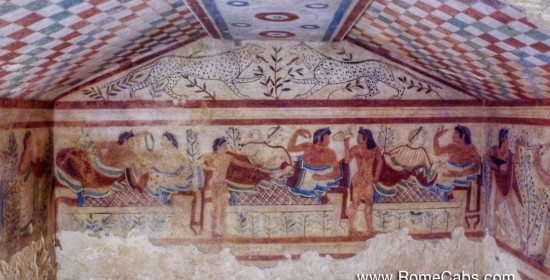
Buongiorno and welcome to RomeCabs, Rome’s top-rated tour company for private tours of Rome, Day Tours from Rome, and Shore Excursions from Civitavecchia.
Located in the picturesque Italian landscape about 1 hour and 20 minutes from Rome and about 25 minutes from Civitavecchia in the Roman countryside, Tarquinia unfolds its archaeological wonders for the curious traveler.
What makes this journey even more accessible is the opportunity to explore Tarquinia's crown jewel – the Monterozzi Necropolis – through convenient day tours from Rome and shore excursions from Civitavecchia.
Featured in our MYSTERIOUS ETRUSCANS Countryside Tour, guests have the opportunity to visit the unique-in-the-world ancient frescoed tombs from 2,500 years ago within the Monterozzi Necropolis.
As a UNESCO World Heritage site, Tarquinia's Monterozzi Necropolis stands as a testament to the artistic brilliance and deep reverence for the afterlife held by the Etruscans. Visitors are treated to an intimate encounter with the underground painted tombs that date as far back as the 5th century BC. The wall frescoes, depicting vibrant scenes of daily life and poignant moments from mythology, provide a captivating glimpse into a civilization that has etched its legacy indelibly into the pages of history.
Normally about a dozen or so tombs are open for public viewing at any given time. The specific tombs that are open for public viewing may rotate to ensure the preservation of these ancient sites. Other factors may include ongoing restoration work and maintenance.
Here, we explore the most must-see Etruscan painted tombs in Tarquinia Necropolis while excluding those with fewer decorative elements. Please note that some tombs featured in this guide could be temporarily closed during your visit.
The Tombs are listed in 3 categories:
-
Painted Tombs Depicting Etruscan Banquets and Daily Life
-
Etruscan Tombs Depicting Demons and Otherworldly Entities
-
Etruscan Painted Tombs with Non-Human Depictions
At the bottom, we also added some helpful information for visiting the underground tombs in Tarquinia’s Monterozzi Necropolis
Get ready for an unforgettable journey through time, where the past comes alive in the subterranean galleries of Tarquinia.
Monterozzi Necropolis in Tarquinia:
Your Guide to the Etruscan Painted Tombs
Painted Tombs Depicting Etruscan Banquets and Daily Life
1. Tomb of the Leopards (Tomba dei Leopardi)
480-479 BC
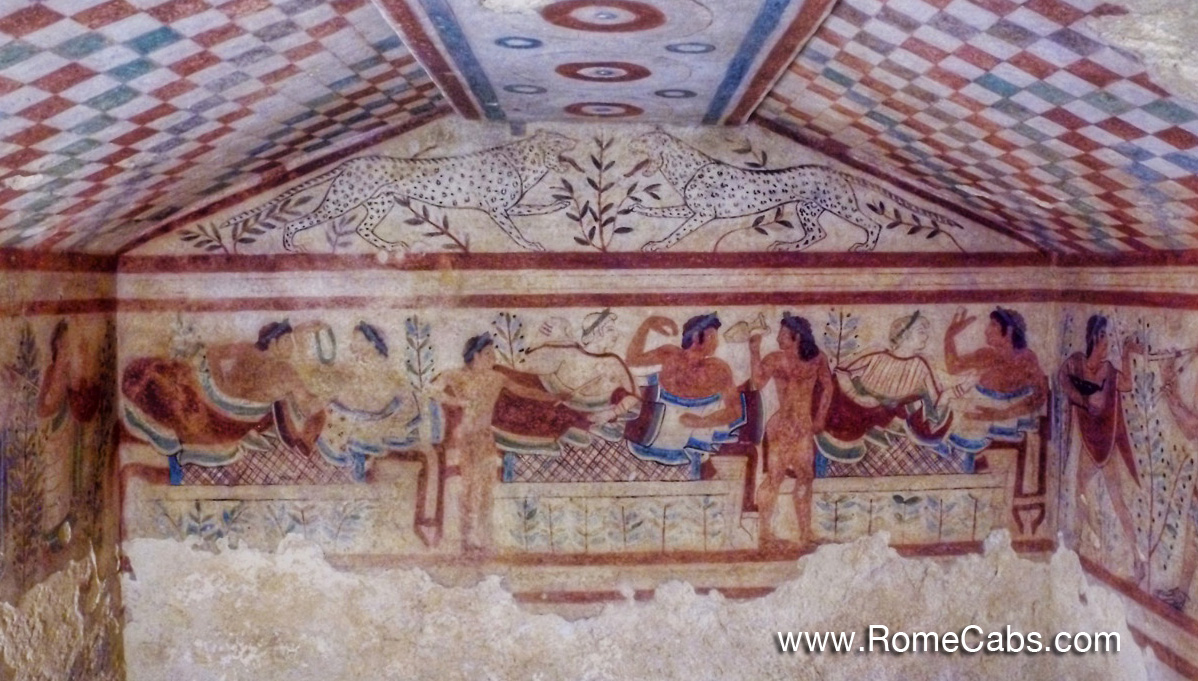
This tomb, characterized by a single room and a double-sloping ceiling, earns its name from the heraldic depiction of two leopards on the pediment. The back wall showcases a banquet scene, with three couples reclining on separate klinai (convivial beds). In this setting, naked servants bring drinks to the diners.
Adorning the side walls are representations of flute and lyre players, dancers, and a small procession of six young men. These figures advance towards the gentlemen at the banquet, bearing offerings in their hands. The Tomb of the Leopards offers a captivating tableau of Etruscan life and customs.
2. Tomb of the Lionesses (Tomba delle Leonesse)
530-520 BC
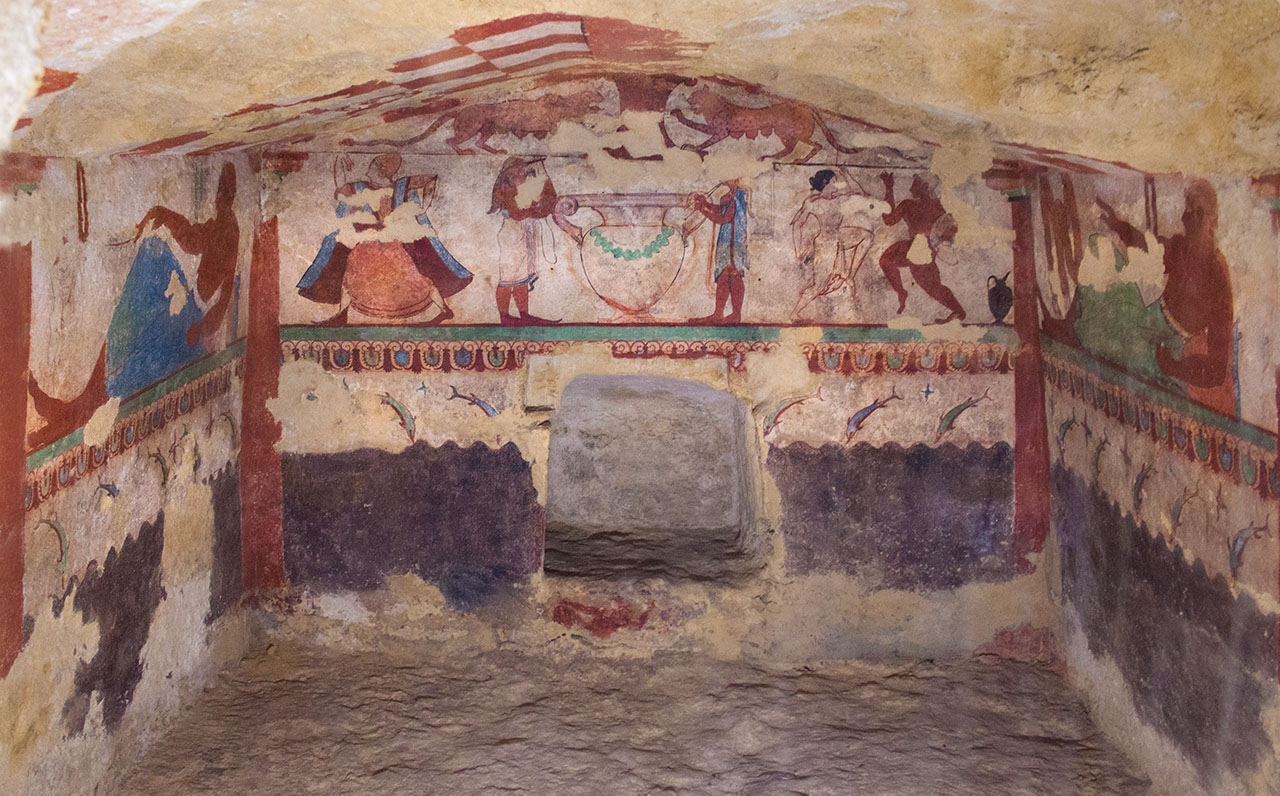
Unearthed in 1874, the Tomb of the Lionesses stands as an archaeological marvel, offering a glimpse into the artistic and social intricacies of the 6th century BC Etruscan civilization.
Comprising a compact quadrangular chamber with a distinctive double-sloping ceiling, the tomb mimics the structure of a pavilion upheld by six Tuscan columns. This architectural choice not only showcases the Etruscans' keen aesthetic sense but also emphasizes the fusion of artistic and functional elements in their burial practices.
The side walls feature depictions of two male couples reclining on cushions, providing insights into Etruscan social customs and relationships. The back wall unveils a vibrant scene of dancers and musicians animating a banquet, capturing the joyous spirit of communal celebrations. Notably, the sides of a sizable crater containing wine add a symbolic touch, underlining the cultural significance of libations in Etruscan rituals.
The discovery of the Tomb of the Lionesses in 1874 enriches our understanding of the artistic sophistication and social dynamics prevalent in the Etruscan society of 530-520 BC. This tomb serves as a testament to the Etruscans' ability to seamlessly blend artistic expression with ritualistic practices, creating a lasting legacy that continues to captivate archaeologists and historians alike.
3. Tomb of the Jugglers (Tomba dei Giocolieri)
6th century BC
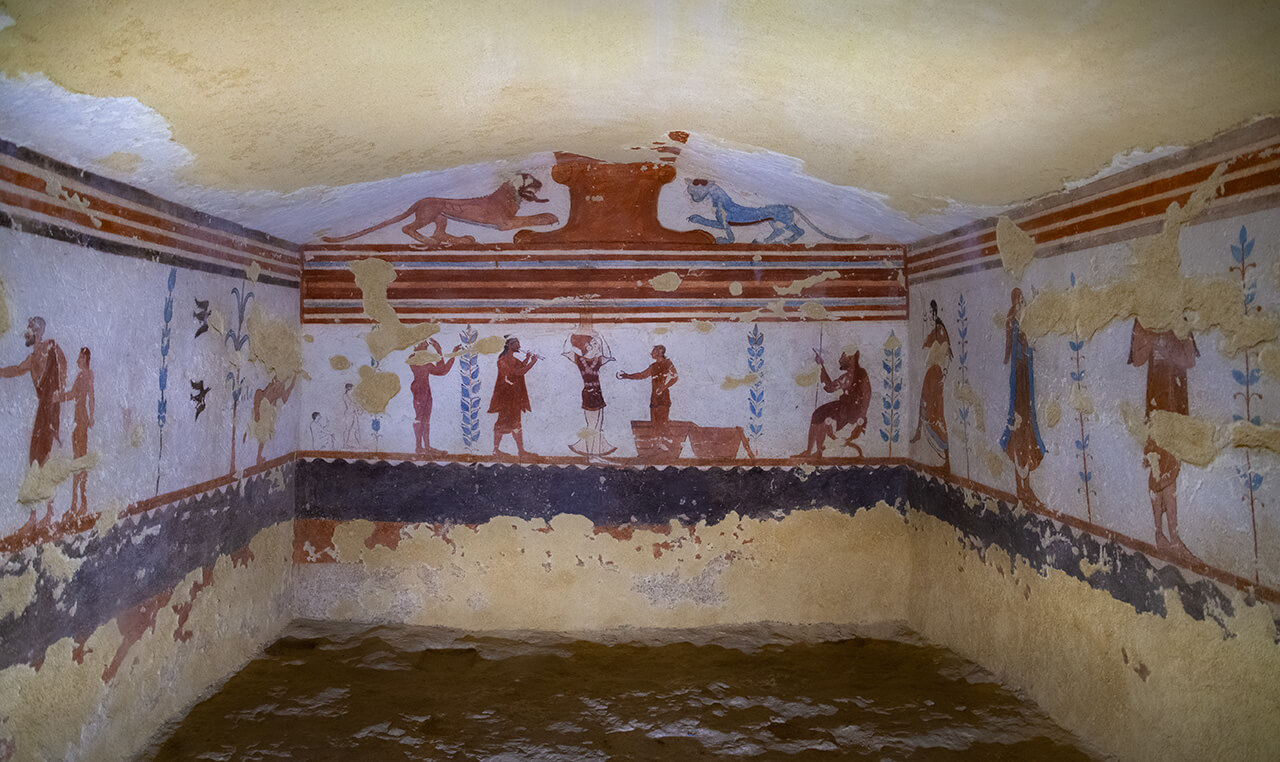
Named for its vibrant depictions celebrating games and dances dedicated to the departed, the Tomb of the Jugglers provides a captivating snapshot of Etruscan funerary customs. Excavated in 1961, this tomb unfolds within a single room, featuring a characteristic double-sloping ceiling.
The wall paintings within serve as a testament to the festive atmosphere intended to honor the deceased. These depictions, celebrating games and dances, highlight the cultural significance of communal festivities in Etruscan mourning practices. The artistic narrative on the walls offers a unique window into the expressive and celebratory aspects of Etruscan life during the 6th century BC.
As of its discovery in 1961, the Tomb of the Jugglers has become a valuable archaeological find, contributing to our understanding of the Etruscan approach to commemorating the departed. The tomb's layout, marked by recesses for the feet of a single funeral bed, aligns with the distinct funerary practices of the time, further enriching the historical context surrounding this intriguing archaeological site.
4. Claudio Bettini Tomb (Tomba Bettini)
Mid-5th century BC
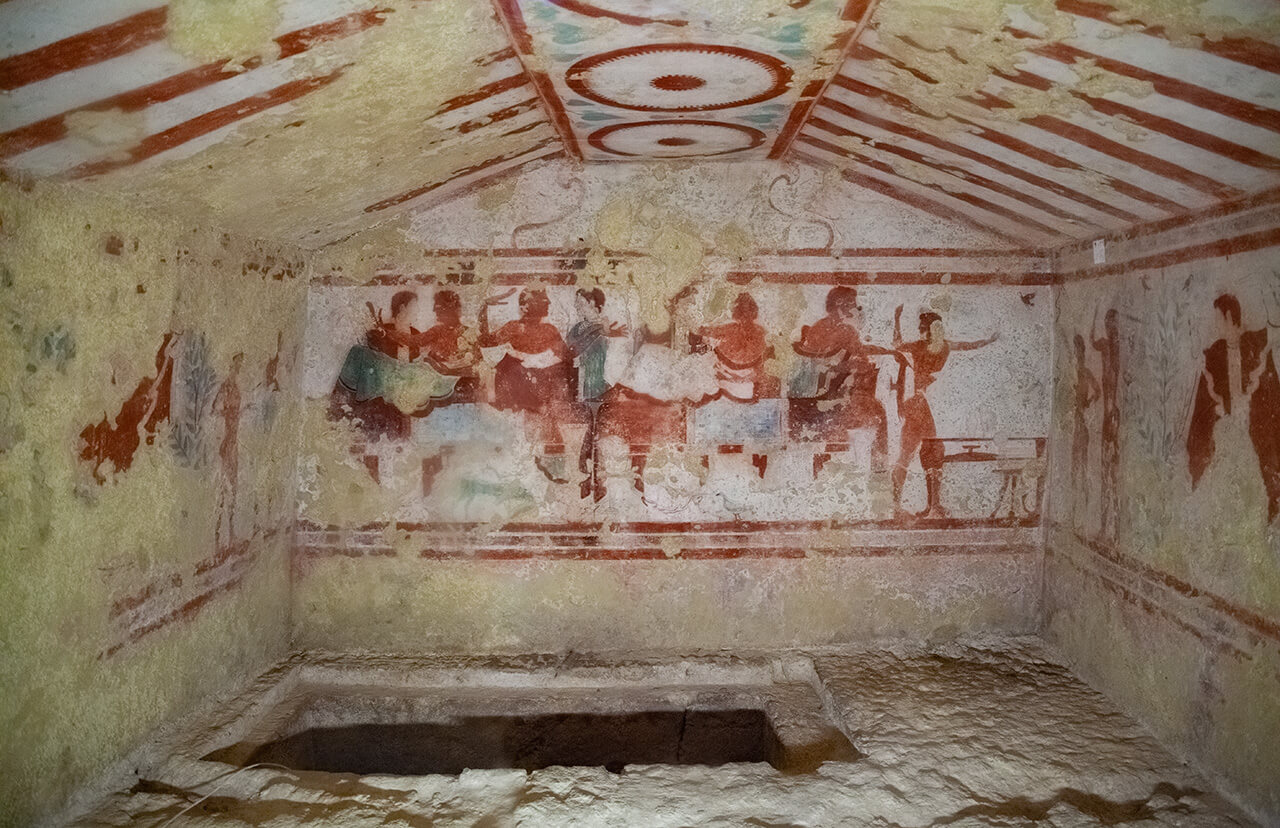
Discovered in 1967, the Bettini Tomb stands as a testament to Etruscan artistry and architectural ingenuity. This single-room tomb features a distinctive double-sloping ceiling, contributing to its unique character.
Recently dedicated to the memory of the architect responsible for the restoration and conservation of Tarquinia's painted Etruscan tombs, this sepulcher carries both historical and artistic significance. The dedication underscores the importance of preserving these ancient treasures and acknowledges the expertise and commitment of those involved in their conservation.
The back wall of the tomb showcases a captivating banquet scene, where two "klinai" (convivial beds) host two couples of men, flanked by standing women. The visual narrative on the side walls unfolds into scenes of dance and music, set against a backdrop of a grove teeming with birds. Delicate festoons adorn small trees, adding an enchanting touch to the artistic panorama.
Beyond its aesthetic charm, the Bettini Tomb serves as a window into the mid-5th century BC Etruscan civilization, portraying not only their social customs and banquets but also their reverence for artistic expression and the preservation of cultural heritage.
5. Pallottino Tomb (Tomba della Pallottino)
Early 4th century BC
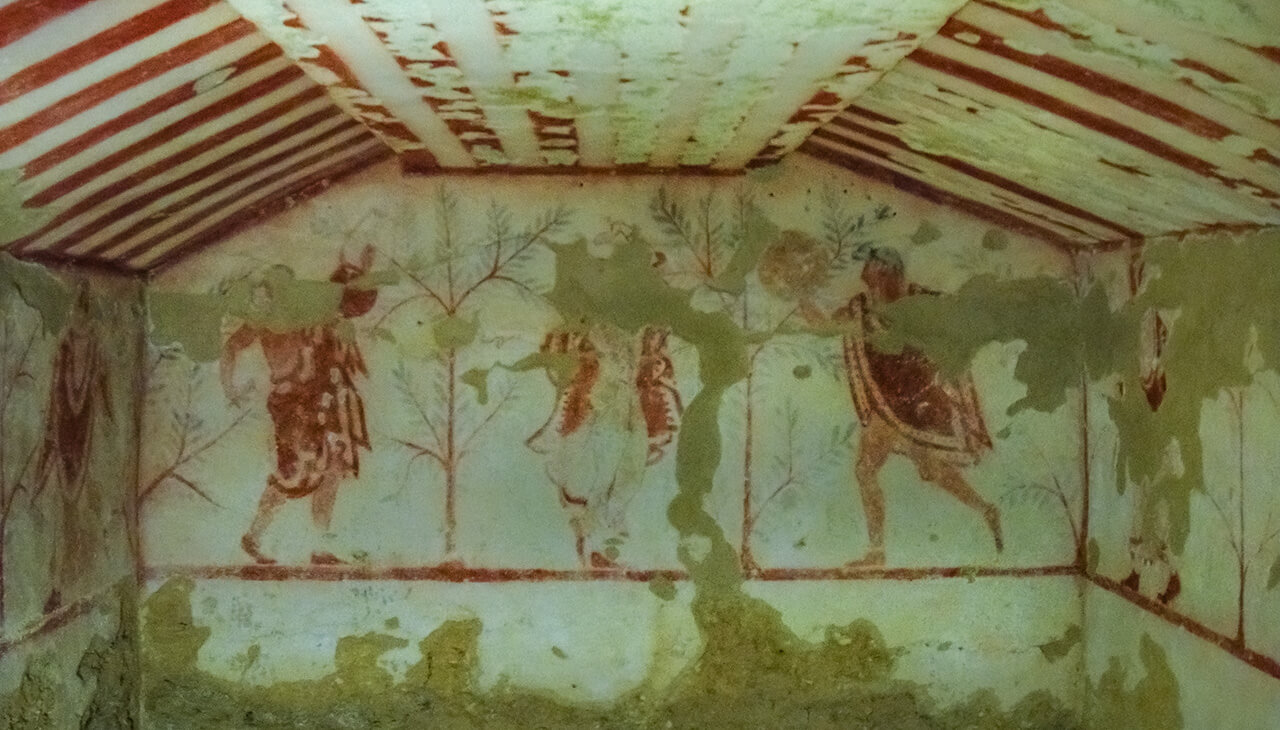
Unearthed in 1962, the Pallottine Tomb stands as a single-chambered structure with a distinctive double-sloping ceiling. This tomb was recently dedicated to Massimo Pallottino, a distinguished scholar and the pioneer of Etruscology, recognizing his profound contributions to the field.
The chamber's walls come alive with vibrant dance scenes, featuring a citador who seamlessly joins in the dance. A striking dominance of the color red pervades the depictions, adding a vivid and dynamic quality to the artwork.
Massimo Pallottino, honored in the dedication of this tomb, significantly advanced the understanding of Etruscan civilization. His legacy extends beyond the archaeological site, shaping the discipline of Etruscology and contributing substantially to our comprehension of this fascinating ancient culture.
6. Tomb of the Maiden (Tomba della Pulcella)
Second Half of the 5th Century BC
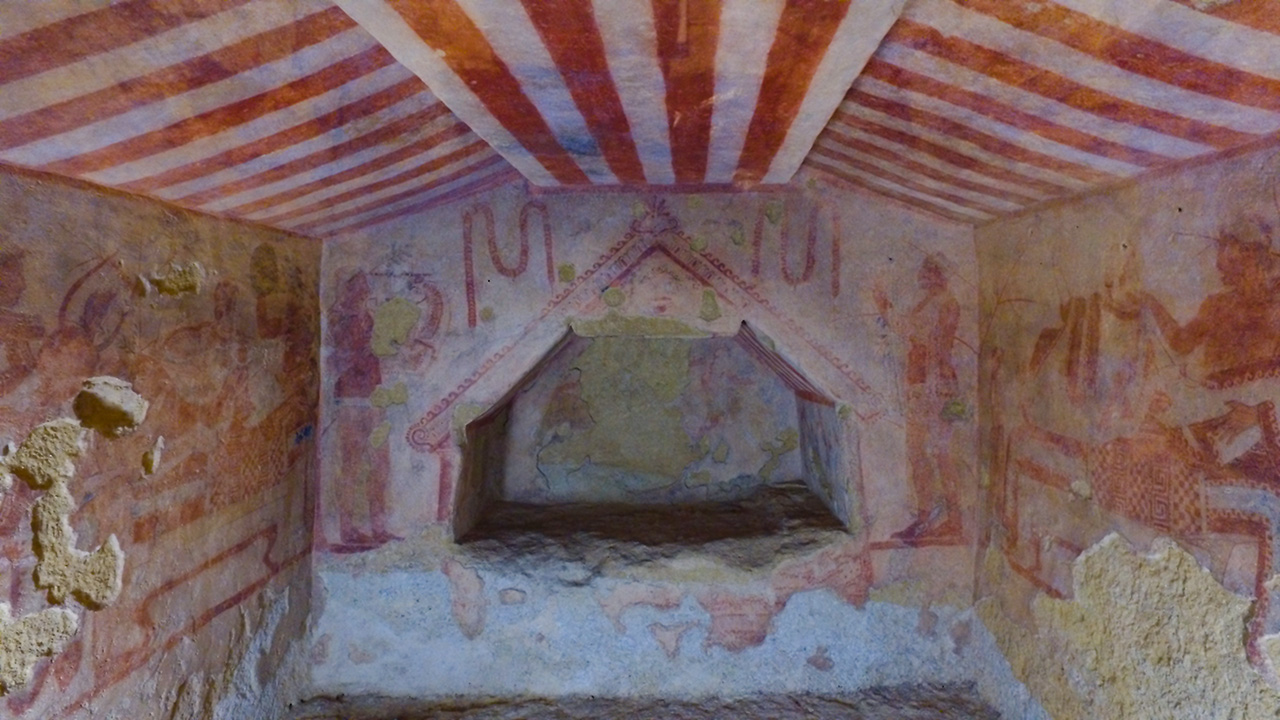
Discovered in 1865, the Tomb of the Pulcella derives its name from the depiction of a young handmaiden adorning the left wall. Accessible through a lengthy corridor, or Dromos, this underground sanctuary unveils a unique sepulchral niche at the center of its back wall, designed in the shape of an aedicula.
The ceiling and central beam are intricately adorned with painted red bands, skillfully mimicking the appearance of wooden beams.
The niche on the back wall is decorated with Tuscan columns and a Gorgon mask positioned on the ridge beam. In the background, ethereal winged geniuses delicately spread a veil over the body of the deceased, creating a scene that resonates with otherworldly grace.
Flanking either side of the aedicula on the back wall are two musicians. The side walls, in turn, come alive with banquet scenes, where pairs of diners, both men and women, recline on convivial beds known as klinai. The level of detail in both pictorial quality and the opulence of the banqueters' attire is nothing short of remarkable.
However, the passage of time has not been entirely kind to this tomb. In 1963, the site fell victim to unknown vandals, resulting in the devastation of the left wall. Tragically, the face of a young maiden, affectionately called the "Pulcella", was marred, and figures of a diner and a little servant were ruthlessly removed.
Despite this act of destruction, the tomb endures, and some pieces have found their way back. The head of the little servant, discovered in a Terman museum, was spontaneously returned and now finds its place of honor in the Archaeological Museum of Tarquinia.
The Tomb of the Maiden is located at the far back of the archaeological park and it’s accessible to wheelchair users via ramps and can be viewed at ground level without having to descend flights of stairs.
7. Tomb of the Bacchants (Tomba dei Baccanti)
Late 6th century BC
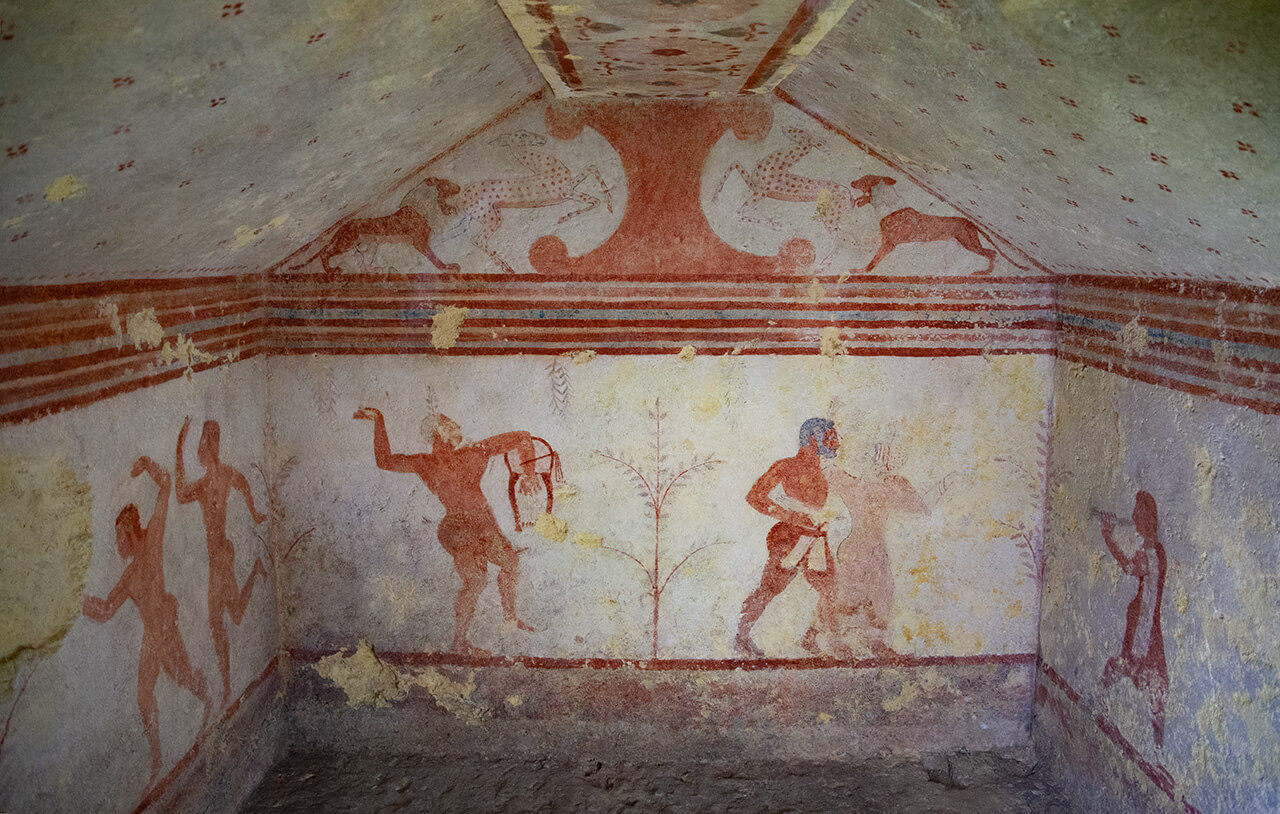
Unearthed in 1874, the Tomb of the Bacchae is a testament to the vibrancy and artistic expression of the late 6th century BC Etruscan culture. Despite its modest size, this tomb stands out as one of the most intriguing painted sepulchers in Tarquinia.
Within the small room featuring a double-sloping ceiling, the walls come alive with representations of drunken dancers and musicians, crowned with vine shoots. These lively figures, separated by small trees, depict the iconic miners or bacchantes, giving the tomb its distinctive name.
The discovery of the Tomb of the Bacchae provides a valuable glimpse into the Etruscans' celebration of life and revelry. This miniature masterpiece not only showcases the artistic finesse of the period but also underscores the cultural importance of Bacchic rites in Etruscan society.
8. Cardarelli Tomb (Tomba Cardarelli)
Late 6th century BC
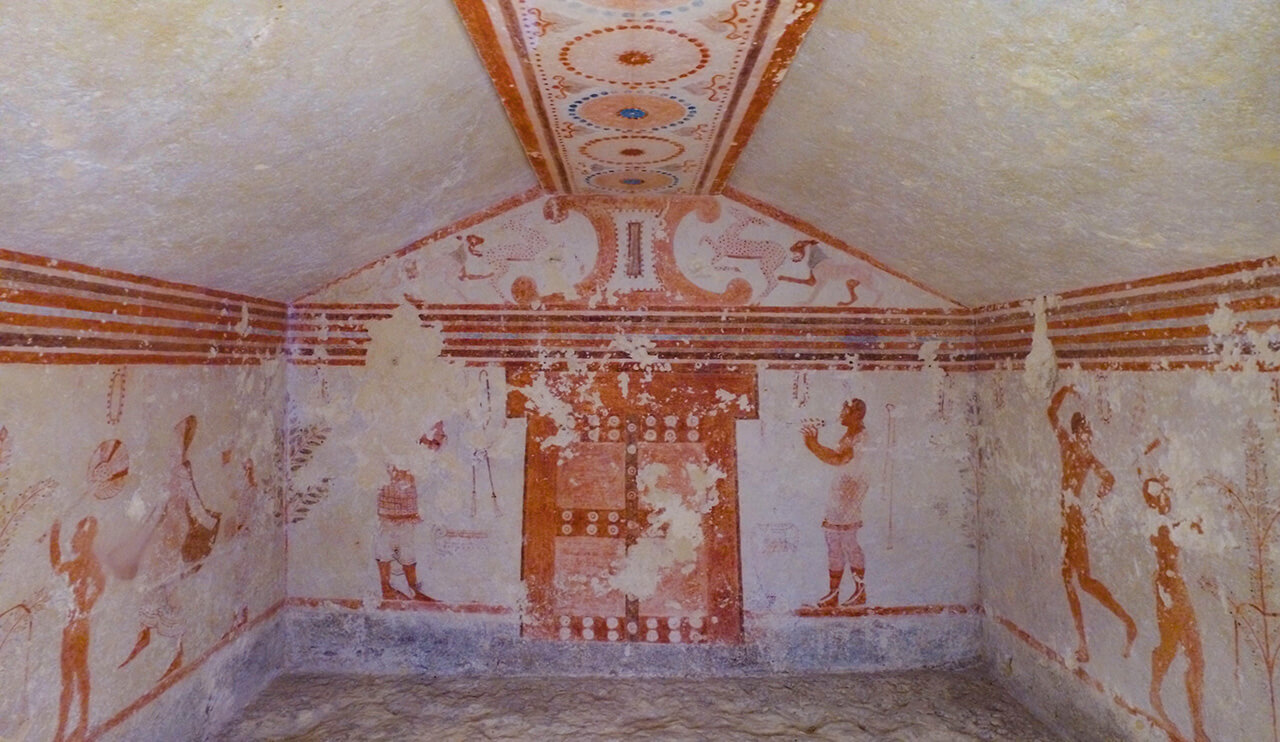
This tomb, dedicated to the esteemed Tarquinian poet Vincenzo Cardarelli, stands as a cultural testament to the late 6th century BC Etruscan society. Adorned with intricate details, the tomb's artistic representations provide a captivating glimpse into the era's customs and social dynamics.
At the center of the back wall, a painted door draws attention, flanked by two musicians. This central motif adds a symbolic layer to the tomb's narrative, perhaps serving as a transition point between life and the afterlife.
The left wall unfolds a scene where a central figure, accompanied by a double flute player, approaches a richly dressed woman. The woman is presumed to be the deceased, given the tomb's funerary context. Preceding her is a slave with a flabellum, and following closely is a handmaid holding a mirror, suggesting a ritualistic or symbolic significance.
On the right wall, a dynamic tableau unfolds, featuring a dancer, a musician, an attendant, and a kottabos (cottabo) player in the act of throwing wine. This lively representation adds a celebratory dimension to the tomb, underscoring the importance of music and entertainment in Etruscan social gatherings.
The Cardarelli Tomb, beyond its dedication to the poet, becomes a portal into the artistic and cultural intricacies of Etruscan life. Its portrayal of rituals, social hierarchies, and festive activities contributes to a nuanced understanding of the society that thrived in Tarquinia during the late 6th century BC.
9. The Tomb of Whipping (Tomba della Fustigazione)
Approximately 490 BC
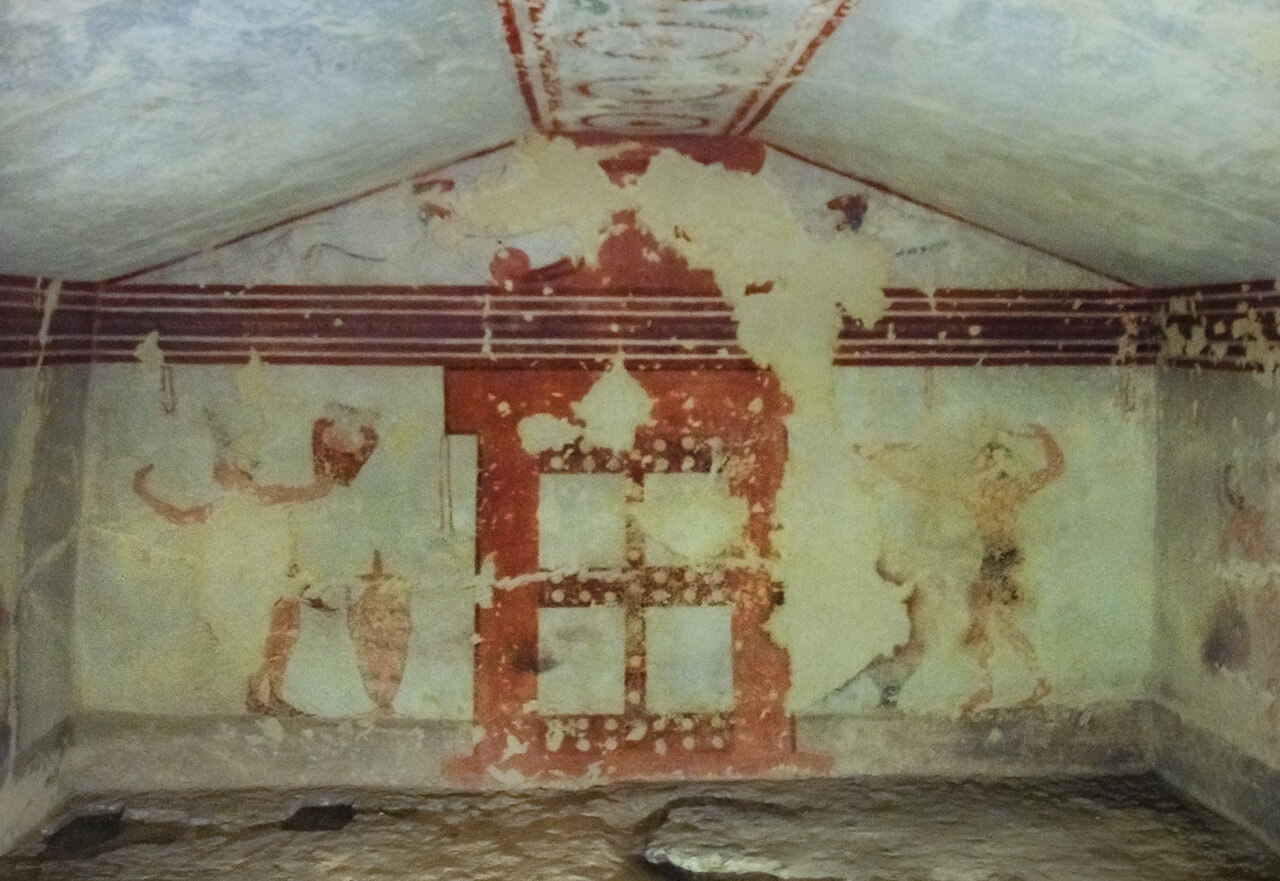
Tomb of Whipping, a singular chamber adorned with a double-sloped ceiling, offers a profound glimpse into the fascinating Etruscan culture. The corridor, or dromos, is a visual symphony of art and symbolism.
The focal point of this sepulchral masterpiece is the trio of False Doors that grace the center of the back and side walls. Each door becomes a portal to a world where life and death intertwine in a dance of extraordinary significance. Behold the intricate scenes depicted on these doors, where human figures come to life in vibrant hues, narrating stories that transcend the boundaries of time.
On the back wall, a citharist and a dancer captivate with their graceful movements, while the left wall introduces a duo of dancers and a flautist, evoking the rhythmic heartbeat of ancient celebrations. However, it's the right wall where two provocative scenes unfold, portraying the provocative act of whipping – a poignant depiction that earned the tomb its intriguing title. The symbolism runs deep, as the exaltation of eros and the orgiastic dance, known as komos, serves as a probable homage to the Dionysian cults that thrived in Etruria during archaic times. This celebration of vitality stands in stark contrast to the inevitability of death, creating a poignant juxtaposition that echoes through the ages.
The False Doors stand as metaphysical thresholds in Etruscan funerary scenes, bridging the realms of the living and the dead. In their closure, they symbolize the eternal journey, a passage from one existence to the next.
10. Tomb of the Warrior (Tomba del Guerriero)
Approximately 430-400 BC
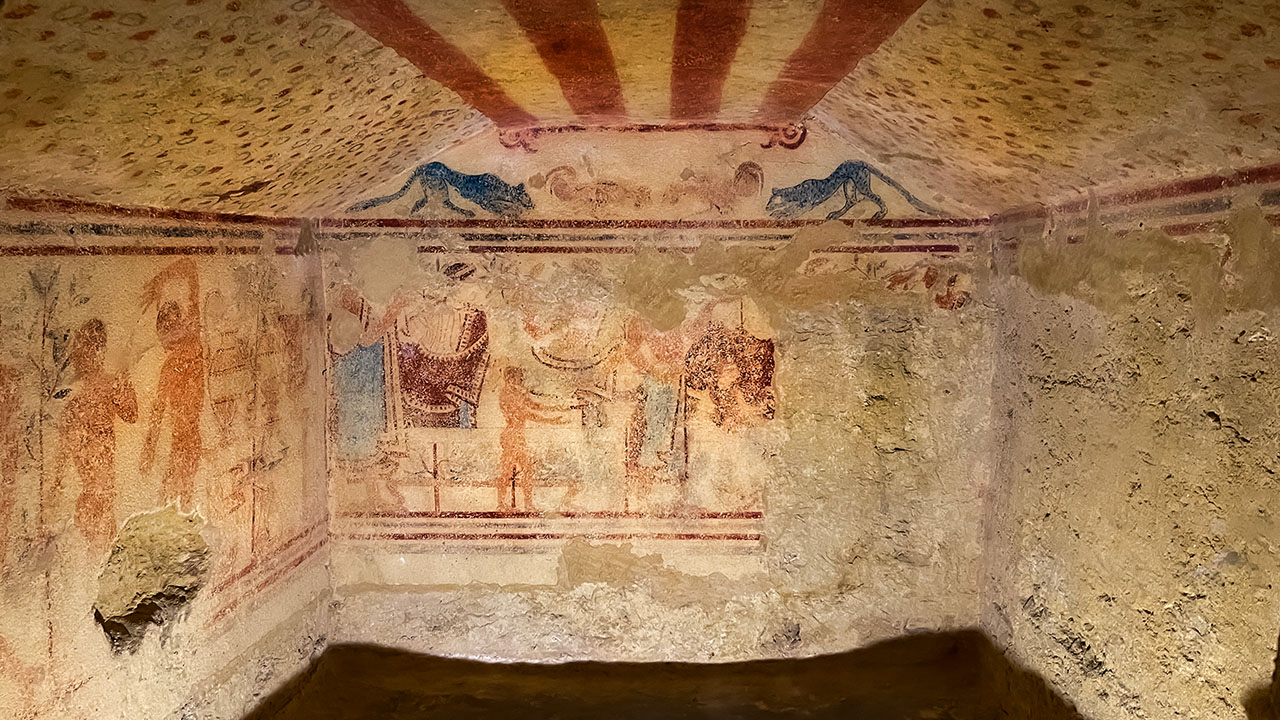
Beneath the pediment, portraying two roosters facing off between two panthers, the walls reveal captivating scenes echoing the themes of symposiums, exhibitions, and funeral games honoring the departed. The central wall narrates the tale of two couples engaged in a banquet on convivial beds (klinai), accompanied by musicians and attendants.
Meanwhile, the left wall features a table adorned with plates and cups (kylikeion), set against the backdrop of athletic performances involving discus throwing, javelin throwing, and boxing. On the somewhat weathered right wall, vestiges of a knight and an infantryman can be discerned. Notably, the tomb derives its name from a captivating figure adorning the entrance wall—an armed athlete dancing to the melodious tunes of a flautist.
The central beam of the ceiling (called Columen) is painted with four red bands. The sloping edges are decorated with small circles and red flowers.
Etruscan Tombs Depicting Demons and Otherworldly Entities
11. Tomb of the Blue Demons - Tomba dei Demoni Azuri
Mid-5th Century BC
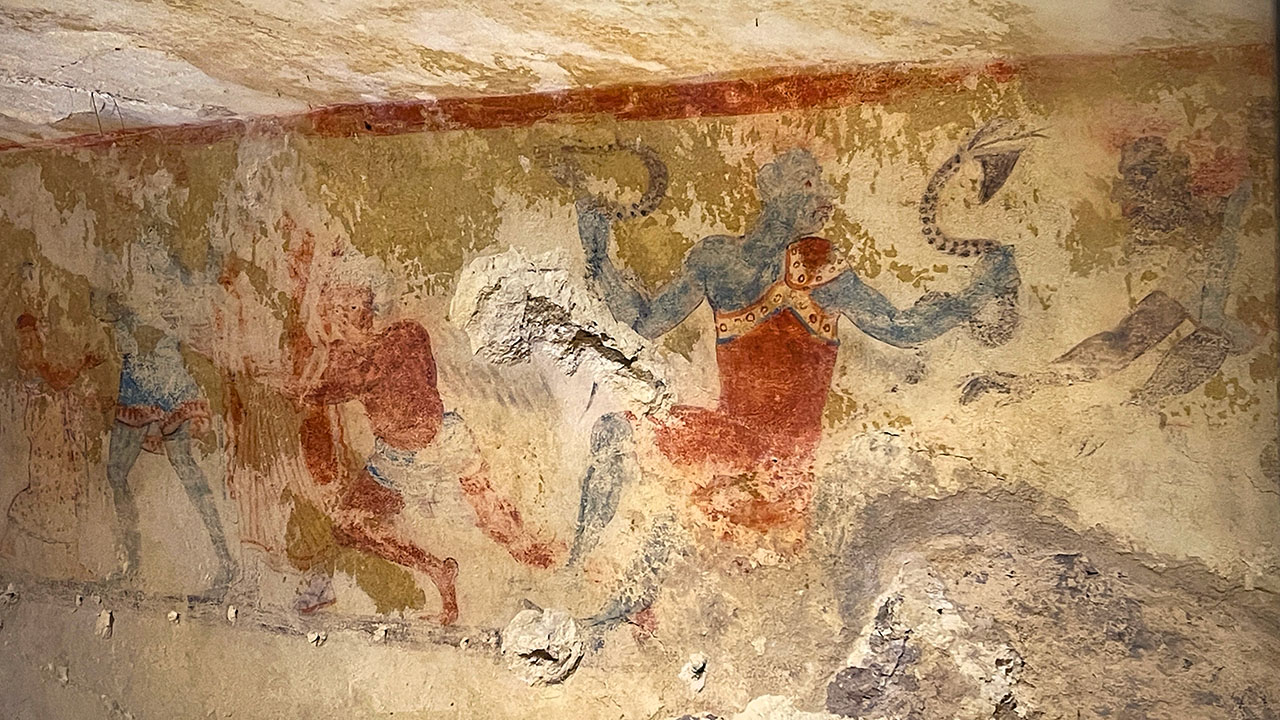
Unearthed serendipitously in 1985, this tomb stands as a profound testament to Etruscan painting, featuring the oldest representation of the Underworld. The figurative narrative unfolds seamlessly, starting at the entrance door and progressing along the two side walls, guiding the departed through their journey towards the afterlife. The narrative culminates on the back wall with a symposium in the Elysian Fields, featuring a central couple. Notably, the depiction of Charon (Charun) emerges for the first time in Etruscan painting, portraying the Greek ferryman steering his red boat with a long oar on the blue waters of Acheron, distinct from the more menacing Etruscan depictions seen in later tombs.
The tomb earns its name from the distinctive demons with blue flesh. Among them, a grotesque figure with bearded snakes encircling his arms sits on a rock. Another, the psychopomp demon, guides the deceased towards the afterlife. A final monstrous being, winged, dark-complexioned, and with a bloodied mouth, lunges with outstretched arms and clawed hands towards the newcomers.
On the left wall, the deceased embarks on their final journey towards the afterlife, standing on a chariot pulled by a pair of horses and accompanied by two dancers. Leading the procession, a young naked cupbearer, positioned next to a laden table, introduces the banquet scene painted on the back wall. Four couples of guests recline on banquet beds (klinai), with the central couple portraying the tomb's owner and his wife exchanging an affectionate caress. The right wall showcases a grandiose scene set in the afterlife, introduced by Charon and featuring a cloaked woman and a young man landing on the shores of Hades, welcomed by other characters.
12. Tomb of the Charuns (Tomba dei Caronti)
First Half of the 3rd Century BC
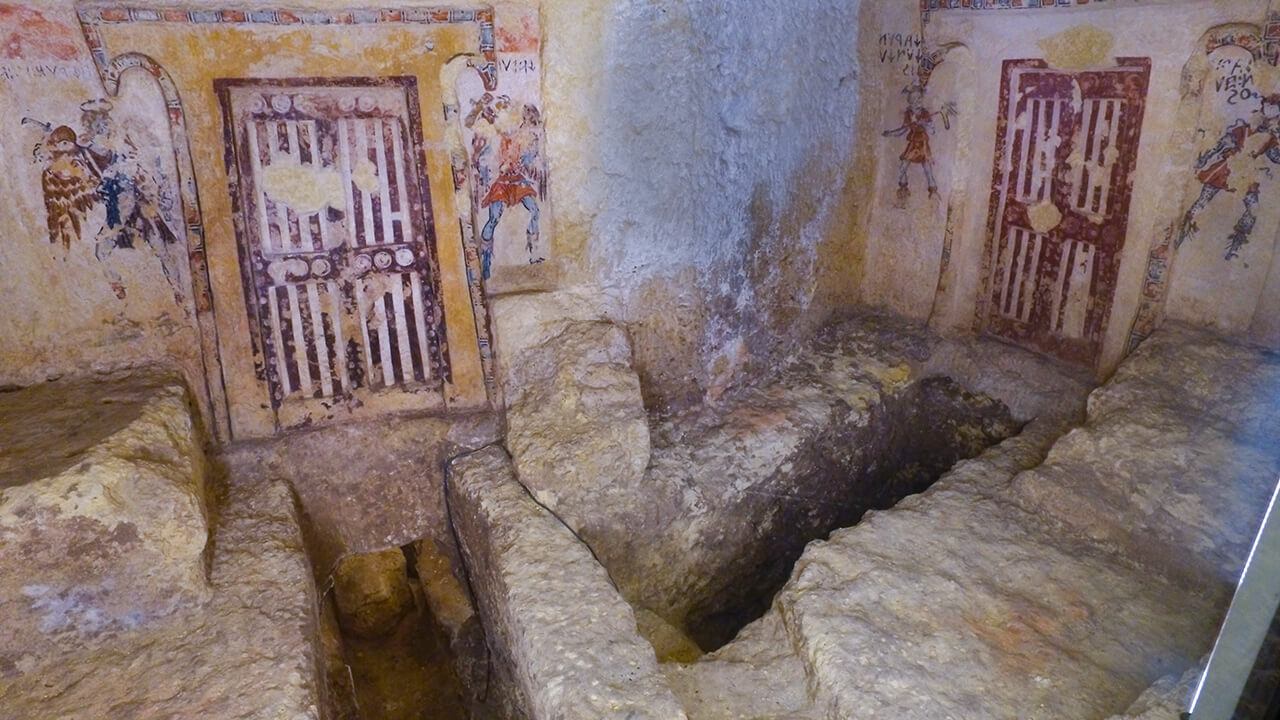
Discovered in 1960, the Tomb of the Charons stands as a remarkable specimen of a two-level tomb from the Hellenistic era, featuring a vestibule. This archaeological find provides a fascinating glimpse into the elaborate burial practices and symbolic representations of the time.
The first floor of the tomb houses a room equipped with platforms, designated for cult ceremonies. From this space, access is granted to two lower rooms through a narrow and steep staircase, where the actual deposition ceremonies would take place. This intricate architectural layout reflects the meticulous attention to ritualistic details in Hellenistic funerary practices.
In the upper chamber, known as the vestibule, intricately carved fake doors adorn the walls. Flanking these doors are depictions of "Charun". The presence of Charun adds a layer of mythological significance to the tomb, intertwining the cultural and religious beliefs of the time with the practicalities of burial rites.
The discovery of the Tomb of the Charons in 1960 enriches our understanding of the Hellenistic period, shedding light on the complex interplay between architecture, mythology, and the afterlife in ancient Etruscan society.
13. Tomb of the Two Roofs (Tomba dei Due Tetti)
First Half of the 2nd Century BC
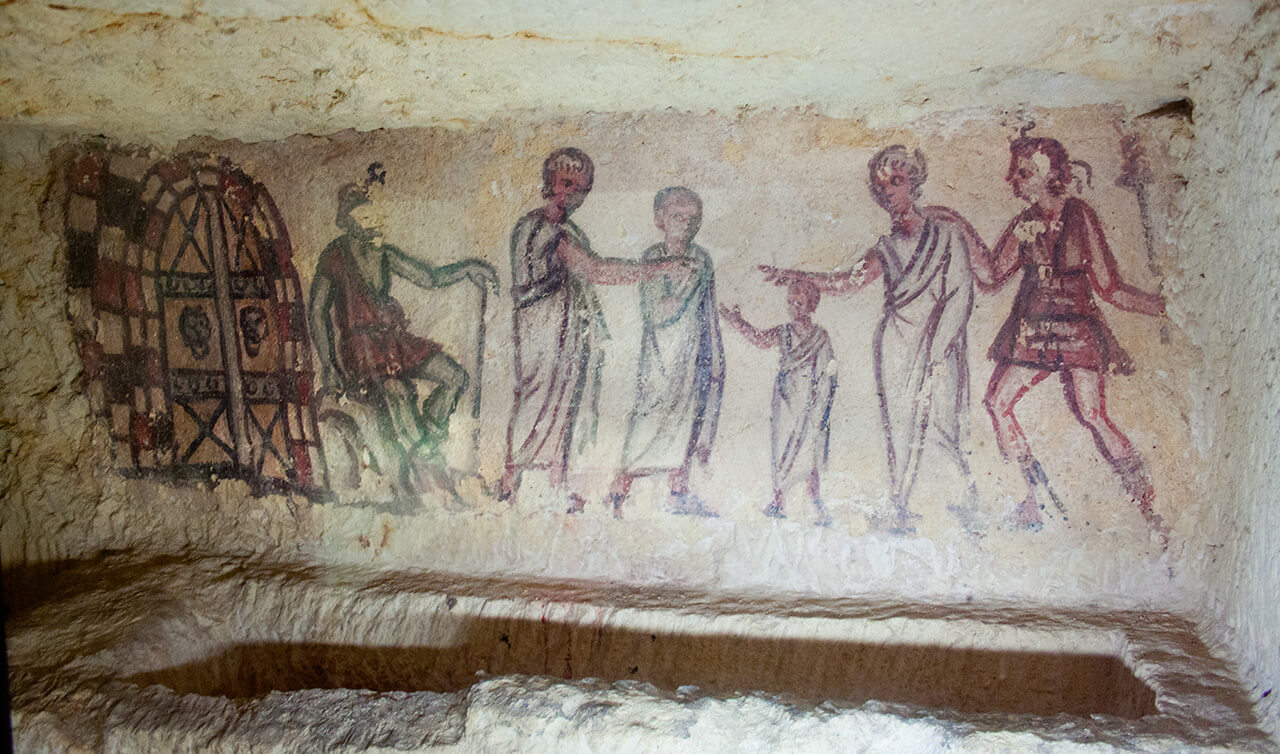
Discovered in 1969, the Tomb of the Two Roofs presents a unique archaeological find that unveils intriguing aspects of Etruscan burial practices during the early 2nd century BC.
At the center of the chamber stands a pillar adorned with a figure of Charun. This central pillar not only serves as a structural element but also carries profound symbolic meaning, underscoring the Etruscan beliefs regarding the journey beyond life.
Inscriptions corresponding to pseudo-sarcophagi line the side walls, adding a layer of ritualistic significance to the tomb. These inscriptions likely play a role in memorializing the individuals interred within and may provide clues about their social status or familial connections.
The right wall of the tomb showcases a figurative and miniaturistic frieze, depicting the journey of the deceased toward Hades. This artistic narrative, while offering aesthetic appeal, serves as a visual representation of the Etruscan conception of the afterlife and the transition from the earthly realm to the realm of the departed.
The discovery of the Tomb of the Two Roofs in 1969 not only contributes to our understanding of Etruscan burial customs but also highlights the artistic and symbolic richness embedded in these ancient funerary practices.
Etruscan Painted Tombs with Non-Human Depictions
14. Bartoccini Tomb (Tomba Bartoccini)
Late 6th century BC
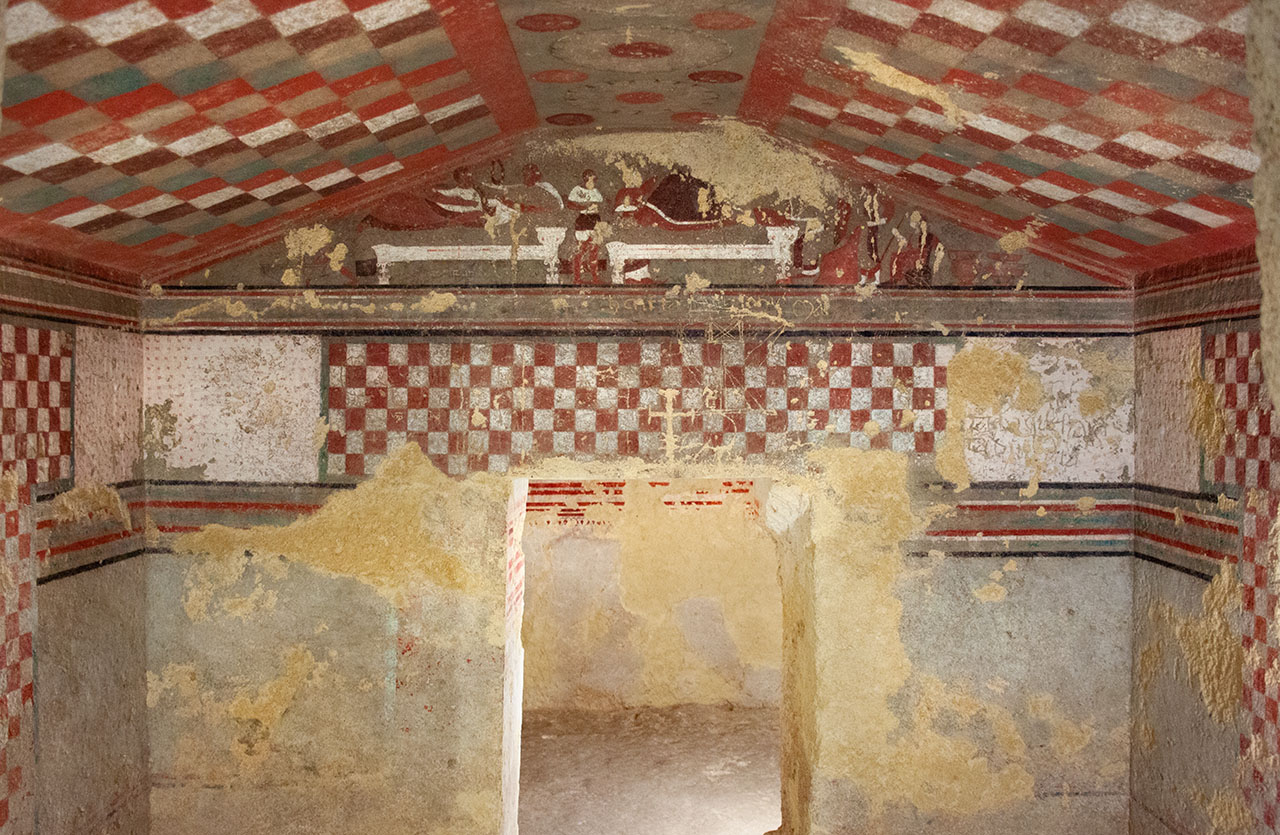
Unearthed in 1959 and dedicated to the Superintendent of Southern Etruria of that era, the Bartoccini Tomb, featuring four chambers, stands out as the most extensive painted tomb, eloquently embodying the concept of a tomb-house. The grandeur begins with the lavishly adorned large antechamber, leading into three passageways, each designated for burials.
The central room boasts sumptuous decoration, including a five-colored checkerboard ceiling and a main beam adorned with concentric circles.
Because the depiction of a lavish banquet is so small in size and easy to miss, we did not include this tomb in the first banquet category. However, there is a tympanum on the back wall that intricately depicts a lavish banquet.
What sets this small banquet scene apart is its uniqueness in Tarquinia during the archaic and classical periods—here, the woman, rather than sharing the kline with her husband, is seated on a throne. This departure from the norm aligns with customs observed in Asia Minor, suggesting a possible connection to families who migrated from Ionia to Etruria.
A compelling mystery surrounds this tomb, manifested in medieval graffiti carved on the Etruscan wall-plaster. Overlooked until 2009, these inscriptions, primarily in Italian vernacular, trace back to the early 13th century, shedding light on activities within the tomb.
Notably, a Latin inscription prominently featuring the Templar, Brother John, as the owner suggests affiliations with the Order, supported by corresponding symbols and titles. Despite the sacred context, the depicted activities, including unconventional practices, prompt speculation on the existence of clandestine Templar rituals. This revelation aligns with the Templar proceedings in the 14th century, underscoring the crypt's significance in the Order's controversial history.
15. Tomb of Hunting and Fishing (Tomba della Caccia e della Pesca)
Last Two Decades of the 6th Century BC
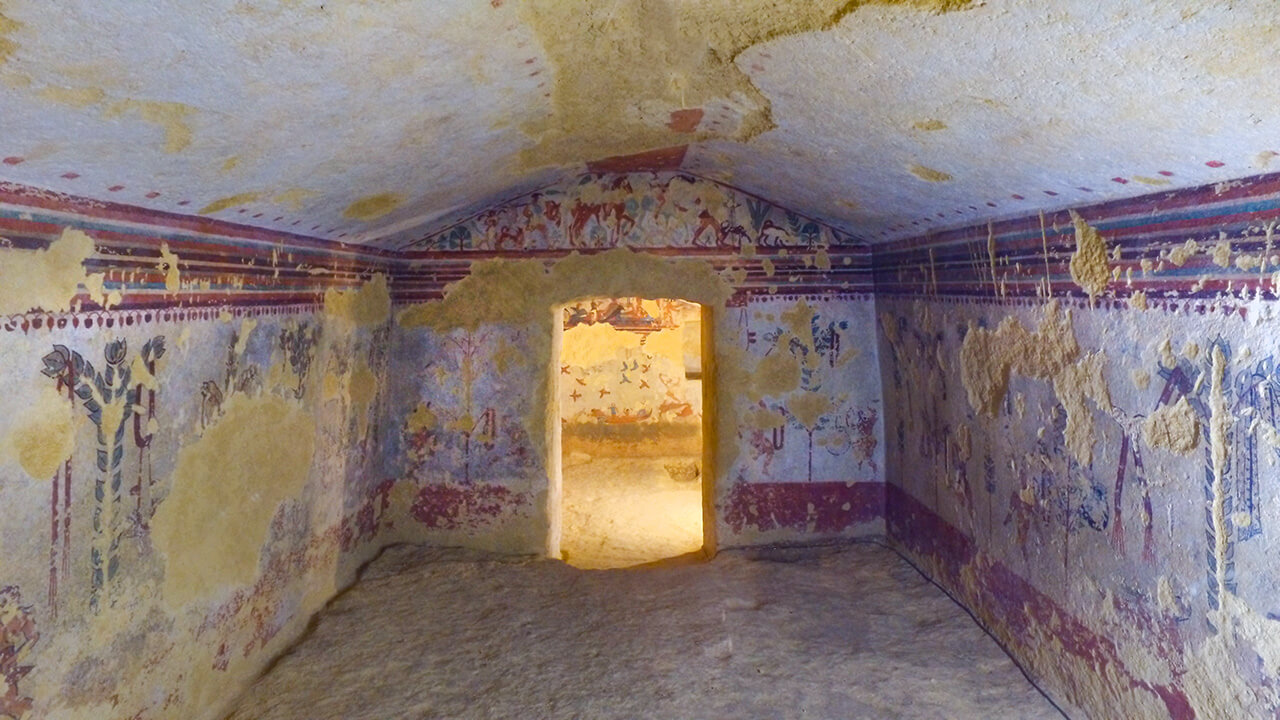
Discovered in 1973, the Tomb of Hunting and Fishing unveils a tale of Etruscan life during the final two decades of the 6th century BC. This tomb, comprised of two axial chambers, offers a visual tapestry that transcends time.
The pediment of the back wall in the first chamber portrays two hunters on horseback, returning from a successful hunting expedition. Moving into the second chamber, a representation of a banquet couple graces the pediment of the back wall. The walls of this chamber come alive with scenes of hunting and fishing, set against a picturesque seascape.
On the left wall, three fishermen in a boat navigate the waters near a rocky formation, from which a naked young man takes a daring dive. The central focus of the back wall captures a boat carrying four men, further enriching the tomb's narrative with maritime activities.
Unearthed in 1973, the Tomb of Hunting and Fishing not only showcases the artistic prowess of the Etruscans but also provides a vivid snapshot of their daily lives, emphasizing the significance of hunting, fishing, and communal celebrations. This archaeological find contributes substantially to our comprehension of the cultural and social dynamics of the late 6th century BC Etruscan civilization.
16. Tomb of the Hunter (Tomba del Cacciatore)
Late 6th century BC
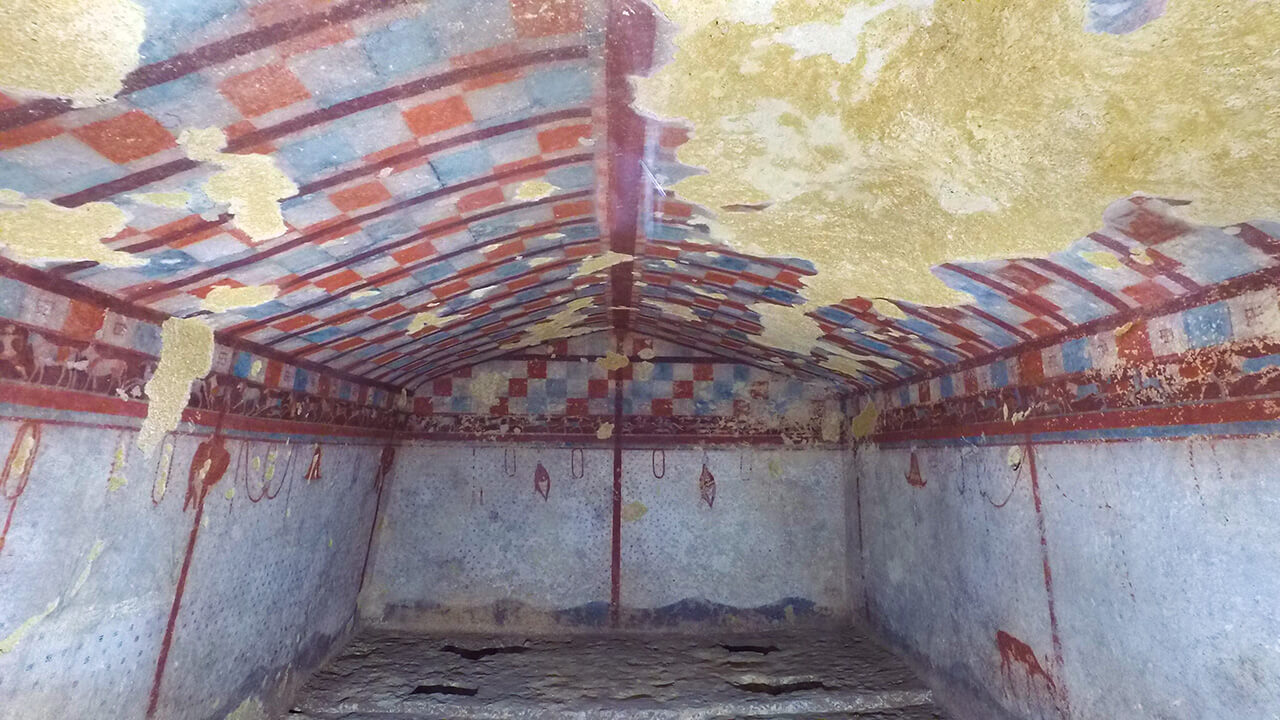
The bomb features an entrance corridor (dromos) with steps, leading to a single-room layout with a rectangular plan and a gabled ceiling. Surrounding the room, there was once a bench with four squared holes designed to accommodate the legs of wooden beds or sarcophagi. The unique painted decoration resembles a tent, complete with a wooden frame and fabric cover.
The ceiling boasts painted poles and a chessboard pattern, framed by a long frieze adorned with depictions of animals, horse riders, and warriors. Hanging from the wooden beam below are flower crowns, sashes, large-brimmed pointed hats, and depictions of hunted game, including wild ducks and deer.
The walls create the illusion of a transparent veil, adorned with a chessboard pattern, through which appear glimpses of a hilly landscape. On the right wall, a grazing deer is prominently painted, a clear nod to the Etruscan nobility's favored pastime of hunting. The tomb's aristocratic character is evident in both its design and decoration. The painted tent serves a dual purpose, depicting a hunting pavilion and symbolically alluding to the tent under which the deceased's body may have been placed during funeral rites.
Now that we covered the most important and decorative tombs, here are some essential tips for visiting the Monterozzi Necropolis in Tarquinia.
Essential Tips for Visiting the Monterozzi Necropolis in Tarquinia:
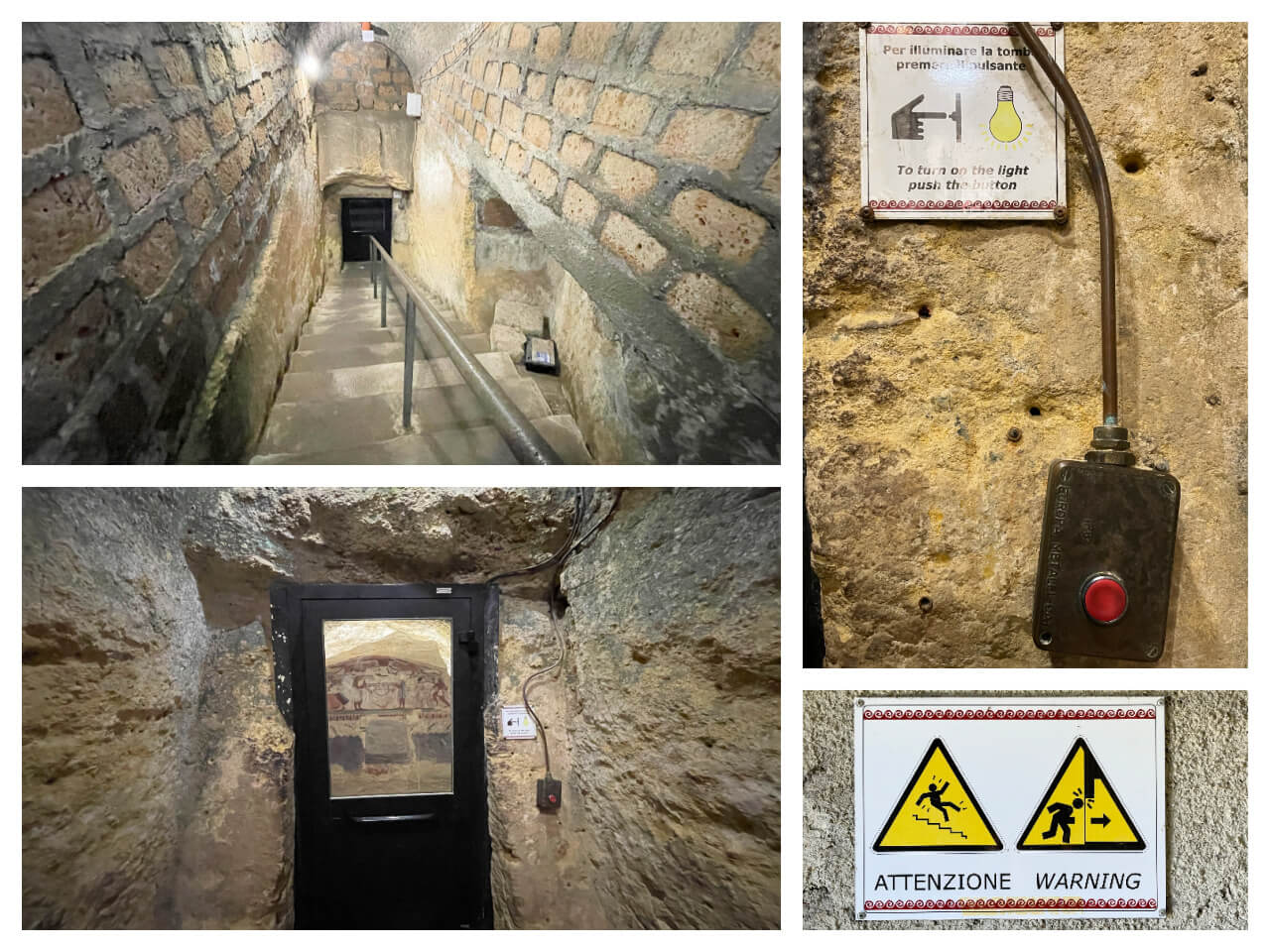
- The Tombs a Flight of Stairs Underground: The tombs at Monterozzi Necropolis are located below ground level, necessitating a descent down an approximate flight of stairs for each tomb you visit. Visitors with mobility concerns are cautioned to evaluate their personal level of ability and stamina as there will be multiple flights of stairs to negotiate in order to visit the tombs.
Currently, wheelchair users can access only the Tomb of the Maiden, thanks to the presence of ramps. This particular tomb offers a ground-level viewing experience, eliminating the need to descend flights of stairs. - Wear comfortable shoes and clothing when visiting the Necropolis.
- The Tombs are sealed in a Climate-Controlled Environment: Due to the fragility of the ancient frescoes, the tombs are sealed in a climate-controlled environment. While this ensures the preservation of these invaluable artworks, it also means that direct entry into the tombs is restricted.
- You can view the Tombs Through Glass Windows: You may view a tomb’s interior through the glass window of a metal door. Get a close look at the intricate frescoes that adorn the tombs while respecting the need for conservation.
- Illuminate the Tombs: Make viewing the tombs possible by pushing the "light button" located near the tomb door. This brief illumination allows you to marvel at the interior of the tomb. To continue viewing to tomb, simply push the light button again.
- Visit both the Necropolis and Museum in one day: Opt for Combo Tickets to explore both the Necropolis and the Etruscan Museum in Tarquinia.
- Book a private guided Tour of Tarquinia’s Necropolis and Museum: If you prefer a more in-depth guided tour of the Monterozzi Necropolis and the Etruscan Museum in Tarquinia, you may book a private guided tour. On our private Etruscan tours, we can book a private licensed tour guide for our guests. Simply inquire with us via email when booking your tour to Tarquinia from Rome or from Civitavecchia.
- Free Visits 1st Sunday of Each Month: Take advantage of free entry to both the Necropolis and Museum on the 1st Sunday of every month.
- Bring home a museum piece Etruscan souvenir: Next door to the Necropolis you have the opportunity to shop for artisan souvenirs such as expertly hand-crafted reproductions of Etruscan pottery and jewelry, as well as snacks and beverages.
